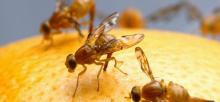
** Advisory **
During the Arizona Department of Agriculture's (AZDA) routine exotic fruit fly trapping activity, one male Mexican fruit fly (Anastepha ludens) was detected near the Interstate 10, in a mainly industrial part of Phoenix.
Efforts are now under way to place considerable more exotic fruit fly traps within the boundaries, west to east, between 67th Avenue and 16th Street, and north to south, between Bethany Home Road and Southern Avenue. The trapping effort is following the U.S. Department of Agriculture's response protocol and will help determine the status of the pest in this area.
You may see inspectors within the 81 square miles of the find, placing and servicing these traps. The traps to help attract the pest to the trap contain a water and yeast solution that is not harmful to humans or animals. The AZDA is working closely with our partners with the U.S. Department of Agriculture's, Animal and Plant Health Inspection Service (USDA-APHIS) in this response activity. Inspectors will always be in uniform with either the AZDA logo or the USDA-APHIS logo. This trapping activity could go on for an extended amount of time and will be evaluated as more information is obtained.
We ask that if you have citrus and you find fruit fly like damage, please leave a note on our webpage and include your name, phone number, email address, location, and a brief description of the damage found. CONTACT US.
In addition, if you are located within the described trapping area, we ask for your help over the coming months to not move fruit out of the area as a precaution.
Exotic fruit flies are not harmful to humans or pets. The primary host of the Mexican fruit fly is citrus, but there are a number of other potential hosts as well. The adult Mexican fruit fly is larger than a house fly, about 1.0cm (0.38 inch) long. The body color is a pale orange-yellow with two to three whitish stripes along the thorax. The wings are clear except for several yellow and brown stripes. The female is distinguished by a long and slender ovipositor which is used to deposit eggs beneath the skin of the host fruit. The maggots (larvae) are legless, and range in color from white to yellowish-white, and grow to a length of 1.0 cm within the host fruit.
For additional information on exotic fruit flies, please see the following page:
